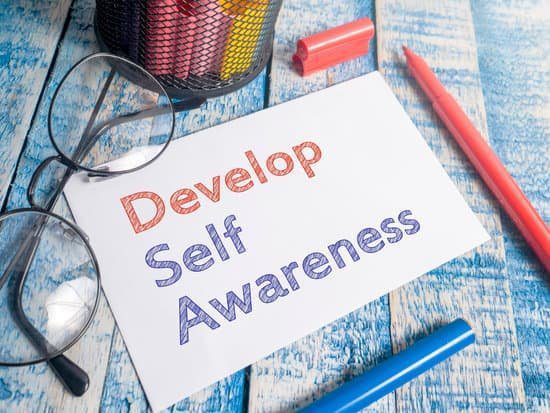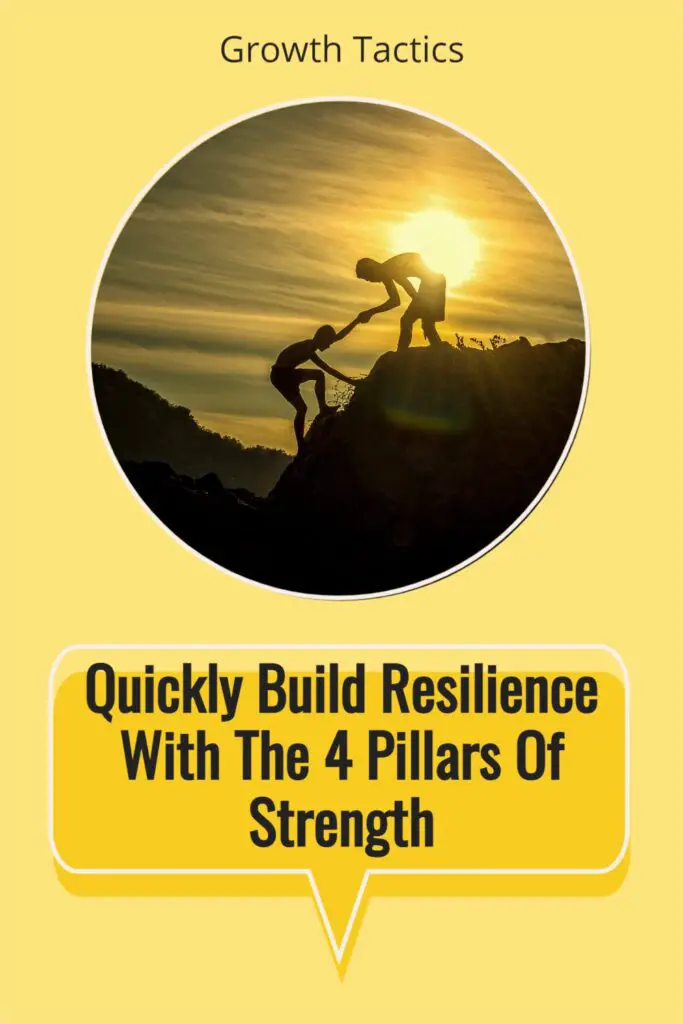Why do some people bounce back from setbacks, while others trip over every hurdle in life? The answer is resilience. Some people are more resilient than others. The good news is that you can build resilience just like any other skill. Learning and adopting the 4 pillars of resilience will increase your ability to bounce back.
Jump To Section
What Does Resilience Mean? (Resilience Definition)
Merriam-Webster defines resilience as “an ability to recover from or adjust easily to adversity or change.”
Simply put resilience is one’s ability to bounce back or recover from adversity.
Adversity is something that affects every one of us at some point in our lives. Your ability to get over that adversity can mean the difference between coming out of a setback stronger. Instead of letting adversity beat you and never recovering from setbacks. Learn these 4 pillars of strength to build resilience and increase your ability to bounce back from setbacks.
How to Use the 4 Pillars of Resilience to Reduce Stress and Bounce Back Quicker

The pillars of resilience are meant to help you before, during, and after adversity. Strengthen these four pillars to avoid adversity, get through adversity quicker, and move on from adversity when it happens.
Not all hurdles in life are created equally, but you eventually recover and make it through all of them. Focus on the four pillars of strength in your life, and you will build resilience at work, home, and anywhere else. Becoming a much stronger person and a better leader.
Don’t be one of those people who lets even the slightest sign of adversity affect you for years. Those types of people believe they are plagued with bad luck. When often, it is self-induced. I’m a firm believer that you create your luck whether it is good or bad luck. That is called a self-fulfilling prophecy.
Physical Pillar of Resilience for Developing Resilience
Physical well-being is the first of the 4 pillars of resilience. There are two main components to physical strength; diet and exercise. To be at your peak having a balance of a good diet and exercise is important. Not only will physical fitness give you more energy, but it is also good at improving brain function. Not to mention the boost to your confidence because you look and feel better. Living a healthy life will help you build resilience and be a happier person in the long run.
Diet
Maintaining a well-balanced diet is the biggest thing most people can do for their health. Most people should be eating a diet low in fat, sugar, and salt, and high in fiber. The daily recommended amount of calories is 2,000 for the average adult male. Now that can vary depending on how active you are and your size, but it’s a good starting point.
Generally speaking, calories are what your body uses for fuel. If you take in too many calories, you will gain weight. If you are at a calorie deficit, meaning you are expending more calories than you take in, you will lose weight. There is a little more that goes into it. Like where your calories are coming from, but that is the basic premise of weight loss. Understanding your calories and eating the right things can help keep your body and mind happy which is important in resilience building.
I recommend avoiding fad diets. Although you typically see very good results initially, fad diets are very hard to sustain and may not be good for your health. Many times you will gain all the weight you lost back and then some, as soon as you stop the diet. It’s better and more sustainable to just start eliminating some unhealthy items in your diet and work on portion control. Even small changes will eventually lead to big results.
For more information on eating healthier click here.
Exercise

The other component of physical strength is exercise. Exercise is great for building muscle and burning calories. There is strength training and cardiovascular training. For the best results, you need to do both strength training and cardio training.
Strength training activities like lifting weights are good for putting on muscle. While you don’t burn calories as fast during strength training activities as cardio training. Your body does burn additional calories after strength training, rebuilding the muscles you broke down.
Cardio is great for burning more calories and great for your heart health. This is why it’s best to have a good mix of cardio and strength training in your workout routine. Men’s Health or Women’s Health are good sites for more information on exercise, diet, and other useful information.
Mental Pillar of Resilience for Psychological Resilience
Mental is the next of the 4 pillars of resilience. The mental pillar is about working on your mental state of mind or psychological resilience. To maintain focus and be the best version of yourself. There are many things that you can do to strengthen your mental pillar of strength. Having a strong mental pillar is vital to building resilience in yourself.
Sleep
Getting the right amount of sleep is vital in maintaining mental strength and building resilience. The average adult needs 8 hours of sleep every night. This number might be a little less or a little more depending on the individual. Your body will tell you if you get enough sleep or not.
When it comes to sleep, having a good routine is very important. Try to go to sleep around the same time every night and try to wake up around the same time. Avoid caffeine and sugary foods close to bedtime. These things can make it difficult to fall asleep. Also avoid or limit screens like television, computers, and cell phones. They produce blue light that can make it much harder for you to shut off your mind at night. Better sleep is crucial to being resilient and increasing happiness.
Work Out Your Brain

Another great way to strengthen your mental pillar and build resilience is by working out your brain. This can be done in many ways.
Reading is a great way to keep your brain working. It doesn’t matter if you enjoy reading blogs, books, or even the newspaper every morning, it all helps keep your brain sharp. Crossword puzzles, Sudoku, and other puzzle games are also great for keeping those neurons firing and building resilience.
Another way to keep your brain working is with apps. There are some great apps out there that can keep your brain healthy. Luminosity is an app that has many brain games focused on improving your memory, reflexes, attention, and problem-solving abilities. The best part is you can enjoy this app for free.
Trying new things and picking up new hobbies can also be a great way to work your brain out. For more ways to keep your brain healthy and become a better person click here.
Reduce stress to avoid burnout
Reducing stress is an essential aspect of maintaining good mental and physical health. When stress becomes chronic, it can lead to burnout, a state of emotional, mental, and physical exhaustion that can be challenging to overcome. Burnout can have a significant impact on your overall well-being and make it difficult to bounce back from challenging situations.
Practicing mindfulness is a powerful technique for reducing stress and increasing resilience. Mindfulness involves staying present in the moment, without judgment, and focusing on your thoughts, feelings, and sensations. By practicing mindfulness regularly, you can develop a greater awareness of your stress triggers and learn to manage them more effectively.
Taking breaks throughout the day can also help reduce stress and increase resilience. Even a short walk, a few deep breaths, or a quick meditation can help you recharge and refocus. Avoid overworking yourself and take regular breaks to avoid burnout.
Finally, prioritizing self-care is crucial for reducing stress and increasing resilience. Make time for activities that bring you joy and relaxation, such as reading, taking a bath, or spending time with loved ones. Taking care of yourself will help you feel more energized and better equipped to handle stress when it arises.
Emotional Pillar of Resilience to Develop Resilience
The next pillar of resilience is the emotional pillar. Emotional strength is a crucial component of your resilience skills. It does not mean being emotionless or hiding your emotions from everybody. It means knowing how to handle your emotions. Having emotional intelligence. It’s perfectly normal to have emotions. At times, we all get mad, sad, nervous, excited, or any other emotion you can think of.
Emotional strength is not so much about how something is handled in the short term, it’s more about the long term. For example, let’s say two athletes play basketball. Both of them suffer a season-ending injury. One expresses anger and sadness immediately following his injury. The other expresses very few emotions. Which one is emotionally stronger?
You may think it’s the athlete who was more stoic about the unfortunate event that had more emotional resilience. In reality, it’s too early to tell.
What if I tell you the athlete who showed emotions right after getting injured, quickly turned his anger and sadness into motivation? Coming back quicker and better than ever. Whereas, the more stoic athlete feared getting injured again and allowed his fear to hold him back, never returning to his old form. Now, which athlete do you think was emotionally stronger? The good news is everybody is capable of strong psychological resilience and emotional strength. It’s all about a positive mindset.
Self-Awareness

Self-awareness is a critical component of emotional resilience. It involves being in tune with your thoughts, feelings, and behaviors, and understanding how they impact your overall well-being. When it comes to resilience, self-awareness is especially important in recognizing negative or excessive emotions and determining their underlying causes.
At times, the cause of negative emotions may be obvious, such as when you receive bad news or experience a significant setback. However, in many cases, the cause of negative emotions may not be immediately apparent. For example, you may feel irritable or agitated without knowing why.
It’s essential to take the time to reflect on your emotions and determine their underlying causes. This requires being honest with yourself and acknowledging any uncomfortable feelings that may arise. For example, if you find yourself constantly feeling anxious or stressed, ask yourself what may be causing these feelings.
Sometimes, negative emotions may be masking other emotions that you are not fully aware of. For example, you may be feeling nervous about an upcoming presentation but instead, find yourself getting angry and agitated. By recognizing the true source of your negative emotions, you can work on addressing the root cause and reducing their negative effects.
Once you have identified the cause of your negative emotions, you can work on fixing it. This may involve making changes to your environment or your behavior, seeking support from others, or practicing self-care. By taking steps to address the root cause of your negative emotions, you can limit their negative effects and turn them into positive emotions.
Turn Negatives Into Positives
Emotional strength is all about using the negatives that happen in your life as motivation. It’s ok to take some time to grieve or cope with the things that happen. Just don’t let it take over your life for too long.
Many people in history have come back from huge setbacks and so can you. Milton Hershey failed as a candy maker three times before perfecting his recipe and becoming one of the most infamous candy makers in history. This was not the only person to fail then come back and become a huge success. For more examples click here.
Accept that you can’t control everything
Accepting that there are things that are beyond our control is a crucial aspect of emotional resilience. Life is full of uncertainties, and no matter how hard we try, we cannot control everything.
One way to practice acceptance is to identify the things that are within your control and those that are not. For example, you cannot control the weather, but you can control how you dress to prepare for it. Similarly, you cannot control the actions of others, but you can control how you respond to them.
Another way to practice acceptance is to focus on the present moment. When we worry about the future or dwell on the past, we lose sight of the present moment. By focusing on the present, we can appreciate what we have and find joy in the moment. Mindfulness meditation is a powerful tool for practicing acceptance and staying present in the moment.
Practicing gratitude is also a powerful way to cultivate acceptance and emotional resilience. When we focus on what we are grateful for, we shift our attention away from what we cannot control and focus on the positive aspects of our lives. Gratitude can help us find joy in even the most challenging situations and build our resilience to stress.
Finally, it’s important to remember that acceptance does not mean giving up or being passive. Acceptance means acknowledging that some things are beyond our control and focusing our energy on what we can control. By accepting what we cannot control and focusing on what we can, we can build our emotional resilience and thrive in even the most challenging situations.
Spiritual Pillar of Resilience

The final of the 4 pillars of resilience is the spiritual pillar. The spiritual pillar is an essential component of emotional resilience. It involves finding your higher purpose in life and staying connected to your values and beliefs, even in the face of adversity. While spiritual strength is often associated with religion, it is important to note that it is not necessarily tied to any specific religious belief.
At its core, spiritual strength is about finding meaning and purpose in life. This can involve connecting with your inner self, your community, or a higher power. It is about staying true to your values and ethics, even when faced with challenges or difficult decisions.
One of the key aspects of spiritual strength is staying grounded and focused on what truly matters. In a world where success is often measured by material possessions or external achievements, it can be easy to lose sight of what is truly important. Resilient individuals understand that success is not worth losing themselves in the process.
Having a belief in something greater than oneself can provide a sense of comfort and perspective during difficult times. This can involve turning to religion, or it can be something entirely personal, such as a connection to nature or a commitment to a particular cause.
Ultimately, the spiritual pillar of resilience is about finding your own path and staying true to yourself. It is about understanding what you believe in and using that belief to guide your decisions and actions. By doing so, you can build your emotional resilience and find meaning and purpose in your life.
This can be your faith, your family, or something else. It doesn’t matter what it is. Just have something that helps you stay grounded and focused.
Embracing a Holistic Approach to Resilience
In today’s unpredictable world, true resilience requires more than just bouncing back. It demands a holistic approach. By integrating various aspects of our lives and strengthening the support systems around us, we can better prepare for and overcome challenges. Embracing this comprehensive strategy equips us to handle whatever the future may hold.
Building a Strong Foundation
At the core of resilience lies a strong foundation. This applies to all areas of our lives, from nurturing healthy relationships to maintaining operational efficiency in our businesses. A strong foundation provides the stability we need to face and overcome adversity.
Fostering Mental Resilience and Emotional Well-being
Mental health and emotional well-being are critical aspects of resilience. Engaging in simple exercises like mindfulness or dedicating time to resilience training can boost our mental resilience. Negative thoughts can often cloud our judgment and impede our ability to recover from setbacks. By fostering a sense of purpose and cultivating realistic optimism, we can navigate tough times with greater ease.
Strengthening Social Supports
Social supports provide the emotional and psychological backing we need. Building resilient networks in our personal lives, ensures we have the resources to cope with challenges.
Encouraging Resilience in Teams and Leaders
Business leaders and team members alike need to embrace resilience. Resiliency programs that include everyone, from the beginning teacher to the seasoned executive, empower organizations to face challenges head-on. Leaders especially should lead by example, demonstrating the importance of resilience in both actions and decision-making.
How to Use the 4 Pillars in Stressful Situations
While understanding the 4 pillars of resilience is crucial, knowing how to apply them in stressful situations can make a significant difference. Here’s how you can utilize each pillar when facing stress:
1. Physical Pillar
- Diet and Hydration: In stressful times, ensure you maintain a balanced diet and stay hydrated. Avoid excessive caffeine, which can exacerbate stress and anxiety.
- Exercise: Engage in physical activity, even if it’s just a short walk. Exercise helps to reduce the levels of the body’s stress hormones and trigger the release of endorphins, which improve mood.
- Rest: Prioritize sleep and rest, as lack of sleep can intensify stress. Create a restful nighttime routine to help your body and mind unwind.
2. Mental Pillar
- Mindfulness and Mediation: Practice mindfulness techniques or meditation to remain present and reduce anxiety. Apps like Headspace or Calm can be helpful.
- Cognitive Restructuring: Challenge and reframe negative thoughts into more positive ones. Cognitive Behavioral Therapy (CBT) techniques can be effective in managing stress.
- Mental Exercises: Engage in puzzles, reading, or activities that stimulate and distract your mind in a positive way.
3. Emotional Pillar
- Emotion Regulation: Allow yourself to express your emotions and then find constructive ways to manage them, such as talking to a friend or writing in a journal.
- Positive Affirmations: Use positive affirmations to boost self-esteem and reduce the impact of stress. Reminding yourself of past successes can build confidence in handling current challenges.
- Gratitude Practices: Focus on what you are grateful for, which can shift your mindset from stress to positivity.
4. Social Pillar
- Seek Support: Reach out to friends, family, or support groups. Sometimes just talking about what’s stressing you out can be a relief.
- Set Boundaries: Ensure you maintain healthy boundaries to avoid taking on additional stress from others.
- Engage in Social Activities: Participate in social events or clubs. Being around others can provide a sense of belonging and support.
By consciously applying these pillars, you can enhance your resilience and effectively manage stress, ultimately becoming stronger and more adaptable in the face of adversity.
Conclusion
Strength is not something you can buy it’s something that has to be worked on every day. Working on these four pillars of strength is a great way to build resilience within yourself. Which will make you an even more amazing person and leader.
Did you enjoy this article on how to use the 4 pillars of resilience to bounce back quicker? Don’t forget to share and subscribe using the buttons below.


